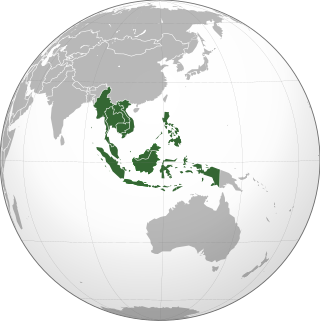
| History of Southeast Asia |
|---|
 |
| Prehistory of Southeast Asia |
| Indianised and Buddhist kingdoms |
| Decline of Hindu/Buddhist influence and sea trade |
| European colonialism |
| World War II and decolonisation |
| Cold War |
| Contemporary Southeast Asia |
The history of Southeast Asia covers the people of Southeast Asia from prehistory to the present in two distinct sub-regions: Mainland Southeast Asia (or Indochina) and Maritime Southeast Asia (or Insular Southeast Asia). Mainland Southeast Asia comprises Cambodia, Laos, Myanmar (or Burma), Peninsular Malaysia, Thailand and Vietnam whereas Maritime Southeast Asia comprises Brunei, Cocos (Keeling) Islands, Christmas Island, East Malaysia, East Timor, Indonesia, Philippines and Singapore. [1] [2]
Contents
- Name
- Prehistory
- Paleolithic
- Neolithic migrations
- Early agricultural societies
- Bronze Age Southeast Asia
- Pottery culture
- Early historical era
- Austronesian maritime trade network
- Indianised kingdoms
- Early relations with China
- Spread of Buddhism
- Medieval period
- Spread of Islam
- Chinese treasure voyages
- Early modern era
- European colonisation
- 20th-century Southeast Asia
- Japanese invasion and occupations
- Post-war decolonisation
- Contemporary Southeast Asia
- See also
- Notes
- References
- Bibliography
- Further reading
- External links
The earliest Homo sapiens presence in Mainland Southeast Asia can be traced back to 70,000 years ago and to at least 50,000 years ago in Maritime Southeast Asia. Since 25,000 years ago, East Asian-related (Basal East Asian) groups expanded southwards into Maritime Southeast Asia from Mainland Southeast Asia. [3] [4] As early as 10,000 years ago, Hoabinhian settlers from Mainland Southeast Asia had developed a tradition and culture of distinct artefact and tool production. During the Neolithic, Austroasiatic peoples populated Indochina via land routes, and sea-borne Austronesian immigrants preferably settled in Maritime Southeast Asia. The earliest agricultural societies that cultivated millet and wet-rice emerged around 1700 BCE in the lowlands and river floodplains of Indochina. [5]
The Phung Nguyen culture (modern northern Vietnam) and the Ban Chiang site (modern Thailand) account for the earliest use of copper by around 2,000 BCE, followed by the Dong Son culture, which by around 500 BCE had developed a highly sophisticated industry of bronze production and processing. Around the same time, the first Agrarian Kingdoms emerged where territory was abundant and favourable, such as Funan at the lower Mekong and Van Lang in the Red River Delta. [6] Smaller and insular principalities increasingly engaged in and contributed to the rapidly expanding sea trade.
The wide topographical diversity of Southeast Asia has greatly influenced its history. For instance, Mainland Southeast Asia with its continuous but rugged and difficult terrain provided the basis for the early Cham, Khmer, and Mon civilizations. The sub-region's extensive coastline and major river systems of the Irrawaddy, Salween, Chao Phraya, Mekong and Red River have directed socio-cultural and economic activities towards the Indian Ocean and South China Sea. [7] [8]
In Maritime Southeast Asia, apart from exceptions such as Borneo and Sumatra, the patchwork of recurring land-sea patterns on widely dispersed islands and archipelagos admitted moderately sized thalassocratic states indifferent to territorial ambitions, where growth and prosperity were associated with sea trade. [9] Since around 100 BCE, Maritime Southeast Asia has occupied a central position at the crossroads of the Indian Ocean and the South China Sea trading routes, immensely stimulating its economy and influencing its culture and society. Most local trading polities selectively adopted Indian Hindu elements of statecraft, religion, culture and administration during the early centuries of the common era, which marked the beginning of recorded history in the area and the continuation of a characteristic cultural development. Chinese culture diffused into the region more indirectly and sporadically, as trade was mostly based on land routes like the Silk Road. Long periods of Chinese isolationism and political relations that were confined to ritualistic tribute procedures prevented deep acculturation. [10]
Buddhism, particularly in Indochina, began to affect political structures beginning in the 8th to 9th centuries CE. Islamic ideas arrived in insular Southeast Asia as early as the 8th century, and the first Muslim societies in the area emerged by the 13th century. [11] [12] [13] The era of European colonialism, early Modernity and the Cold War era revealed the reality of limited political significance for the various Southeast Asian polities. Post-World War II national survival and progress required a modern state and a strong national identity. [14] Most modern Southeast Asian countries enjoy a historically unprecedented degree of political freedom and self-determination and have embraced the practical concept of intergovernmental co-operation within the Association of Southeast Asian Nations (ASEAN). [15] [16]
















































